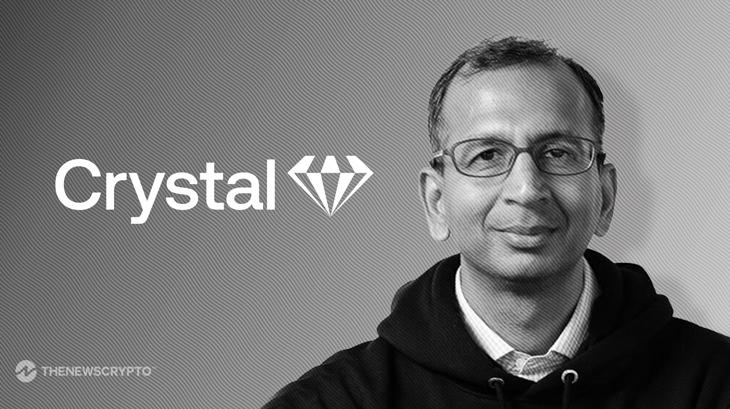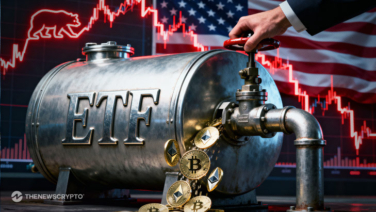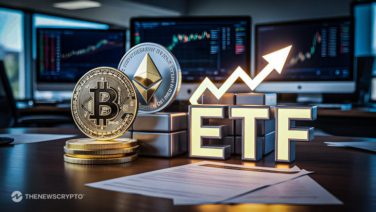In the ever-changing world of cryptocurrencies and blockchain, staying ahead requires more than intuition; it demands data-driven strategies. In an insightful interview with Navin Gupta, the CEO of Crystal Intelligence, we delve into the future of crypto, dissecting trends, regulations, and the pivotal role of analytics.
Navin begins by explaining the shifting narratives within the crypto space. While trends come and go, Crystal Intelligence stands firm on data-driven insights. With a surge in new capital entering the crypto ecosystem monthly, propelled by U.S spot Bitcoin ETFs and the recent approval of Bitcoin ETFs in Hong Kong, a new era of sustained growth emerges. Drawing parallels to the Bitcoin boom, Navin predicts a wave of entrepreneurialism, as early adopters reinvest their wealth into bringing up the next generation of crypto ventures.
TheNewsCrypto: With the completion of Bitcoin halving and spot Bitcoin ETF approval in Hong Kong grabbing huge attention, Which is the next narrative you are the most bullish on?
Navin Gupta (NG): The whole cryptocurrency industry moves from narrative to narrative, with different trends like Bitcoin, NFTs, or DeFi. But we are the people who just believe in the data because that’s our strength. However, focusing on data reveals a significant trend: a steady inflow of new money into Bitcoin, with investment vehicles like Blackrock and many other ETF investments. This consistent investment, totaling double-digit billions of dollars monthly, comes from individuals previously outside of the crypto world, adding stability to the market.
Drawing parallels to the Bitcoin boom of 2008-2024, we witnessed the emergence of giants like PayPal, Amazon, and Facebook, often led by visionary individuals dubbed the “PayPal Mafia” or “Facebook Mafia.” Following their success, these pioneers reinvested in and mentored countless young entrepreneurs, catalyzing the next wave of innovation. Similarly, in the crypto realm, early adopters are leveraging their Bitcoin wealth to support and mentor newcomers, fostering a self-sustaining ecosystem. However, the entry of ETF capital into Bitcoin reduces volatility and encourages reinvestment in various crypto projects, resembling the Bitcoin era’s diversification. This cycle of mentorship and financial backing heralds a promising future for the crypto sector, transcending mere narratives to drive real value and innovation.
TNC: What’s your perspective on DeFi?
NG: DeFi (decentralized finance) is here to stay because it addresses a key issue: reducing the hefty fees imposed by centralized institutions on transactions between buyers and sellers. However, it’s important to recognize that some level of Know Your Customer (KYC) compliance is necessary in this space as well.
Currently, DeFi and traditional finance operate as separate sectors, with minimal interaction between them. However, it’s foreseeable that they will begin to converge soon. For instance, imagine if someone from centralized finance (CeFi) offers a better price for a transaction between two individuals within the DeFi space. In such a scenario, they might be willing to undergo KYC procedures to access this better deal.
In this envisioned future, there could exist a platform within the DeFi ecosystem where users can undergo identification and KYC processes. Institutions seeking to transact with AML (Anti-Money Laundering) and compliant participants within the DeFi space could then interact with them. While currently separate, these worlds may eventually overlap, allowing for collaboration between traditional institutions and the DeFi sector.
TNC: Memecoins have dominated as one of the most attractive digital assets, offering significant gains to investors. What is your view on the market dynamics of memecoins? Do you believe it is a short-term buzz or a long-term?
NG: From a skeptical viewpoint, meme coins are often criticized as scams or speculative assets with little to no intrinsic value. Many argue that investing in these coins is akin to gambling, as their prices can be highly volatile and they may ultimately plummet to zero. This perspective highlights the risks associated with meme coins and warns investors to proceed with caution.
However, others see them as straightforward and honest. Meme coins don’t pretend to be anything more than what they are – memes – and they offer a simple way to participate in the crypto world. While they may not have much practical use, they provide entertainment and speculation for those involved. So, opinions on meme coins vary, with some seeing them as risky and others appreciating their simplicity and honesty.
TNC: What advice do you have for people unsure about distinguishing between legitimate meme coin projects and scams, especially considering the growing number of projects entering the market?
NG: Simply put, meme coins aren’t for everyone. It’s crucial for people to understand the risks involved before investing, especially if they’re not familiar with the cryptocurrency sector. For most ordinary individuals, it’s wise to avoid significant investments in meme coins altogether.
However, there will always be individuals who are drawn to the speculative nature of meme coins, much like how some people enjoy sports betting. Just as sports betting is legal in many countries and cultures, meme coin trading is legal in jurisdictions where cryptocurrency activities are permitted. As long as individuals are fully aware of the risks and make informed decisions, they have the right to engage in meme coin trading. It’s not for anyone else to judge their choices, provided they’re acting within the bounds of the law and with a clear understanding of what they stand to gain or lose.
TNC: What’s your perspective on regulations of the market, given the uncertainty?
NG: Regulatory frameworks for cryptocurrencies are evolving rapidly, especially in major jurisdictions like Europe, the US, Japan, Hong Kong, and the UAE. These regulations aim to bring clarity and accountability to the crypto space while protecting consumers and combating issues like tax evasion and financial crime.
With regulations like MiCA in Europe and directives from agencies like the FCA, firms operating in the crypto sector are faced with clear choices: comply with the regulations or operate in the unregulated space. This dichotomy ensures that consumers are aware of the risks associated with dealing with licensed versus unlicensed players in the market. Licensed firms offer consumer protections and legal recourse in case of disputes, while unlicensed entities may not provide such safeguards.
This regulatory environment benefits consumers by providing them with the information needed to make educated decisions about where to entrust their funds. It also fosters innovation by creating a framework where crypto businesses can operate securely while adhering to regulatory standards. Collaborative efforts between regulators and industry players, such as providing data and analysis, help ensure that regulations support innovation while safeguarding consumers. Ultimately, these regulations aim to strike a balance between fostering innovation and protecting consumers’ interests in the rapidly evolving crypto landscape.
TNC: What’s your perspective or prediction for the market, particularly regarding Bitcoin (BTC) in 2024?
NG: In summary, while it’s hard to predict Bitcoin’s future, several trends are shaping the crypto market. The introduction of ETFs is bringing new investors into the market, expanding its size and legitimacy. Stablecoins are revolutionizing global transactions, benefiting businesses by reducing transaction times and paperwork. Additionally, the potential for a breakout Web3 gaming space with engaging gameplay and robust economic incentives could create a vibrant community and marketplace within and outside the gaming sector, further driving growth in the market.
Moreover, the burgeoning potential of Non-Fungible Tokens (NFTs) and the inception of Bitcoin and Ethereum ETFs underscore an evolving narrative, promising further expansion and diversification within the market. These trends collectively paint a picture of a dynamic and evolving crypto landscape, marked by innovation, accessibility, and growing mainstream adoption.
TNC: Moving forward, what strategies/plans do you have in place to onboard the next set of users entering the crypto space?
NG: At Crystal Intelligence, our ethos revolves around customer obsession. Drawing from my own experiences, such as building an Uber equivalent for trucks in India and working at Ripple, I’ve ingrained a deep commitment to understanding and serving our customers’ needs. Today, our customers seek data-driven insights to make informed decisions, eschewing sentiment-based approaches. We aim to cater to this demand by providing comprehensive analytics that delves into user profiles and behaviors. Whether it’s understanding how individuals utilize wallets on exchanges or unhosted wallets, we strive to uncover valuable insights to guide investment strategies and identify target demographics. This data-driven approach extends across various sectors within the crypto industry, from exchanges to stablecoin issuers to gaming companies. Our mission is clear: empower our customers with actionable insights derived from data, enabling them to make informed decisions that drive success in their ventures.
Disclaimer: The information provided in this interview article is for informational purposes only. It is not intended to be, nor should it be construed as, investment advice, financial guidance, or a recommendation to make any specific decisions. Readers are encouraged to conduct their own research.








